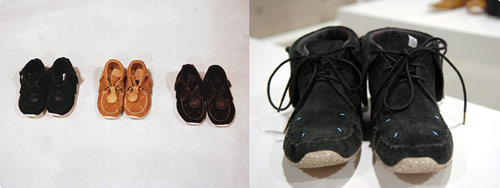| ── The “FOLK” line came into existence as a new series for Visvim. Would you explain the line to us? |
|
| Hiroki Nakamura (N) |
|
Well, the simplified version is that I just wanted to create “something good,†and I guess the inception of our FOLK series began with that intention. But at first I didn’t really know what qualities this “good product†should have. I thought about it over and over again, but not of what features or specifications it should contain, but something more at the core of what every good product has intrinsically, the very qualities that make something good… And all good things share similar qualities. With this in mind, as I traveled extensively, I began seeing hints in ancient things ï¼ things which have existed for centuries, or things which have been heavily used for long periods of time. I noticed very old Italian structures built from stone, rustic items from daily life in Tibet, etc., taking full advantage of the surrounding natural materials and making the best possible usage of these easily available materials. Seeing these things changed my awareness of natural “products,†and changed my opinion of how materials can be used. |
|
| ── You mean that your aim is not at making superficial luxury shoes. The brand is not trying to improve its image by saying ‘ecology before economy.’ |
|
| N: |
Well, it’s most important that our shoes are as comfortable as possible, but in order to achieve this we first have to know what a “good product†is. We feel it’s not only valuable to look at things past down from generation to generation, but important to offer new things that can be passed down to future generations. We’re not denying technology so to speak, but rather exploring what its significance is to and for our culture and society. |
|
|
| ── Have you any doubts about high technology, if it actually will be of use to people? |
|
| N: |
I do, actually. I think it’s important to verify that a technology is helpful to manufacturing, or whether it’s only being used as a tool of marketing… |
|
| ── Using the function of natural materials and technology effectively. It might be the ultimate technology. |
|
| N: |
Well, I’m not a naturalist or an ecologist by any means, so my methods for creating product are very different from how these kinds of people would approach a design problem. But I did take hints from some of their ideas. Maybe some people will try to label us as a high-end eco brand or something because of it… |
|
|
| ── Visvim was well known as a street brand, so the people who have a superficial way of thinking might feel Visvim is trying to be a trendy eco brand or luxury brand, because you are using high quality leather as a material. |
|
| N: |
Well, I don’t really care how people label us (laughs)… Because I know what we need to do: Focus our attention on making good things only. It’s completely up to the customer how to style our product and how to enjoy it. If one of our customers has luxurious tastes, I’m sure they could adapt our product to fit. Or if a customer is more aware of ecological issues and our product is attractive to them because of it, that’s fine, too. The most important task for us is to simply be honest with our product. Image or labels aren’t a huge issue at all. If people think our product is comfortable to wear, that’s the best. All we want to do is make good product. Nothing more. |
|
| ── That is to say, your new “FOLK” line is the answer to your doubts. An updated version of the FBT moccasin will be launched as the first piece, then to follow a basic high-quality tennis shoe called the Foley. |
|
| N: |
We’ve used very soft leather for the Foley, our tennis shoe model. The leather is vegetable-tanned, and it is very absorbent of moisture. The lining is made of soft leather as well, and it won’t interfere with the breathability of the outer leather. These shoes really breath when you wear them…You don’t need socks. As for the FBT, we’re calling this version the “Bear Foot,†which is a homophone of being barefoot, and this shoe closely mimics authentic vintage native North American moccasins. I actually collect tribal moccasins, so I knew that only one layer of leather is used for the outsole, but if we make modern shoes with this method people would find them uncomfortable and their feet would become tired very quickly from walking. To resolve this issue, we used Vibram outsoles to keep the profile as low as possible and keep the shoes looking as authentic as we could. |
|
| ── You are obviously particular about products. You have devoted yourself to making good ones. I can even see this kind of thought present in your attitude. |
|
| N: |
Well, I guess you can say I’m a “product fundamentalist†(laughs). As a matter of fact, we’ve used this as the theme for our Spring/Summer 2008 Dissertation (laughs). Thorough investigation and research during development is important. There are a lot of products out there that are the direct result of marketing alone, but hopefully the people who are becoming tired of this will naturally gravitate toward our brand and product. |
|
|
| ── It seems like your way of thinking regarding products motivated you to create this “FOLK” series. Now that the line is completed, are you more confident of your philosophy? |
|
| N: |
Well, I always stumble upon new techniques or materials during development stages when I least expect to, and these discoveries are a great stimulus for me. They definitely help with developing creativity. Seemingly small discoveries at the time always help everything else move forward, and are a great aid in actualizing ideas. I’ve had several moments in the past 8 or so years that have been like this, one of which was when I first launched Visvim, another was the inception of the FOLK series. I’m excited for this next stage in our company’s evolution. |
|
| ── You mean, Visvim has now entered a new phase? |
|
| N: |
I think so. I’m enjoying making these new products, and we’re all looking forward to how our customers will react. |
|
|
| ── Everytime I listen to you speak about your product, the same question always comes to mind, “Why have you chosen this way?†There are other options open to you. For instance, you can manipulate your brand image, or concentrate your attention on developing the brand’s value and put your creativity on that act. What do you think about these other options? |
|
| N: |
Some people control their brand’s image nicely and develop their business that way. I think that’s great. But it’s not my way. I could, of course, put focus on other elements of our business but I’m much more particular about products than anything else. It’s just the way I am. |
|
| ── I understand what you mean, but isn’t it quite difficult to develop the quality every time you make something new? Moreover, you should be fair to the business as well. It sounds tough. |
|
| N: |
Indeed it is. We have to announce new collections by the quarter, and it is hard for designers to create something progressive and new every time. Capitalist economies require things to be dealt with in very limited time-frames, but the step-by-step processes needed when making good products don’t always match these kinds of schedules. The systems don’t really align. |
|
|
| ── Yes. Because of the system, the average span of each product’s life is getting shorter and shorter. It seems like everything is becoming disposable in our society. |
|
| N: |
I think people are starting to realize this problem. For me, I just don’t want to be in a situation where everything around me is the result of a marketing machine. |
|
| ── I see. This is the final question. What is the point of making shoes? Or rather, why are you so crazy about it? |
|
| N: |
It’s a tough job to manufacture footwear, but I really enjoy the process and the outcome. Footwear componentry is complex and hard to make, and as if that weren’t enough, the second a person puts on a pair of shoes they can immediately tell whether or not they are comfortable. Shoes are reliable items and functional tools in our culture, while also having the potential to be very attractive items. For these reasons, the footwear design process intrigues me, and I don’t see that intrigue fading any time soon… I guess it’s my nature to make shoes. |
|





